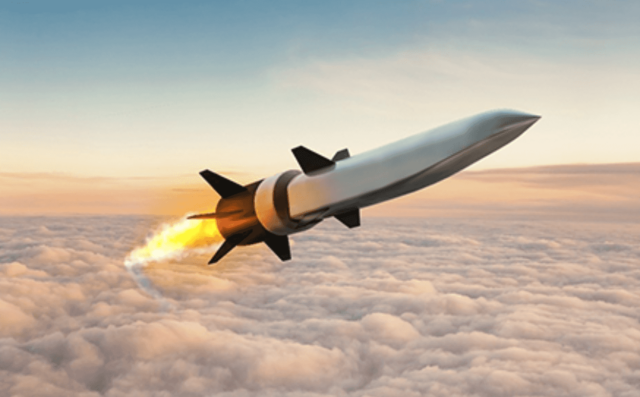
China wants to own the hypersonic ‘domain,’ DOD official says Hypersonic Air-breathing Weapon Concept (HAWC). (DARPA image/Released)
China sees the area of hypersonic weapons—those that can maneuver at Mach 5 or faster—not as a missile race but as an entirely new domain of warfare, Gillian Bussey, director of the Defense Department’s Joint Hypersonics Transition Office, said Monday. One consequence: the United States will have to rely on a wide range of layered defenses to protect military assets from a potential onslaught.
The Chinese “often use the terms near-space and hypersonics interchangeably,” said Bussey. “Near-space” refers to altitudes between 20 and 100 kilometers: higher than most airliners, lower than the heights achieved by ICBMs. That suggests that they are “approaching hypersonics as a domain, like land and sea.”
While big breakthroughs like last July’s hypersonic test garner big headlines, Bussey noted that China has for years experimented with different technology combinations to get at that altitude layer. “You can look at their papers,” she said. “They have lighting scramjet vehicles; they have glide vehicles with scramjets….vehicles with liquid rocket, solid rocket propulsion. There’s a whole host of propulsion systems that they are working on.”
It’s easy to lump hypersonic missiles in with nuclear weapons. The key nuclear-armed hypersonic missiles that both countries are developing certainly fall into that category. But Mark Lewis, the executive director of the National Defense Industrial Association’s Emerging Technologies Institute, has concerns about the smaller weapons as well.
“It’s really the tactical systems that I worry about the most,” Lewis said during Monday’s event Imagine a hypersonic missile swarm that can sink an aircraft carrier; that’s really quite a capability. And that leads to us asking the question: are we willing to risk an aircraft carrier say in a potential scenario?”
Various U.S. military services are pursuing hypersonic missiles; the Pentagon requested a total of about $3.8 billion for the work in fiscal 2022. The budget request for hypersonic defense technology was far lower: around $248 million through the Missile Defense Agency, or MDA, plus around $7 million for a three-year-old DARPA program called Glide Breaker. On top of that, the Space Development Agency is launching a constellation of satellites to track highly maneuverable hypersonic missiles. These would work to “cue the MDA’s hypersonic and ballistic tracking space sensor…to provide more precise target-quality data so that you could actually develop a fire solution that would allow you to intercept that weapon,” said Kelley Sayler, an analyst for Advanced Technology and Global Security at the Congressional Research Service.
Said Bussey, “Despite the obvious threat, as a department, we’ve chosen to focus on offense, first, because a good offense is the best defense—and offense is a lot easier.”
But a CSIS report released at Monday’s event highlights the need to have layered defenses. The most important element is probably anti-hypersonic interceptor missiles, which will be far harder to create than offensive missiles intended to hit stationary or relatively slow-moving targets.
Bussey said her office has been looking at new formsof infrared sensing technology and new radio frequency antennae to outfit such interceptors. But those will require big scientific breakthroughs to develop materials that allow the particular spectral energy loads to reach sensors inside the seeker while still protecting that seeker from the high temperatures generated by flying through the air at five times the speed of sound.
You also need to “understand sources of optical distortion for [infrared sensors] sensors such as ablation or erosion on [infrared] windows and what the hypersonic airfoil looks like over that window” she said.
The United States is also looking at directed energy, such as lasers or microwave beams, to destroy hypersonic missiles. But the same tracking and guidance challenges would affect those as well. The Defense Department doesn’t expect those to come online until the 2030s—with a good chance they will arrive “much later than that,” noted Sayler.
The CSIS report also highlights the importance of “passive” defenses like decoys and “other forms of deception to confound hypersonic weapons’ terminal guidance systems.”
Commanders need to start now to conceal key command nodes or valuable assets from hypersonic missiles.
“Critical air and missile defense nodes could also be concealed in mobile and containerized platforms, along with decoys, to complicate targeting,” the report said. “Operational procedures can also improve survivability. Additional investments in training for damage control and runway repair, coupled with the unpredictable rotation of forces between bases, could mitigate the destruction or disruption of forward-deployed forces.”
Lewis said the Defense Department needs to appreciate that hypersonic weapons won’t just be an aspect of the future battlefield but its defining feature. “This can’t be a few years’ effort [where] we deploy a couple of systems, and then we move on. Because this is the future of warfare and we need to be in this race,” he said.
___
© 2022 Government Executive Media Group LLC
Distributed by Tribune Content Agency, LLC.




